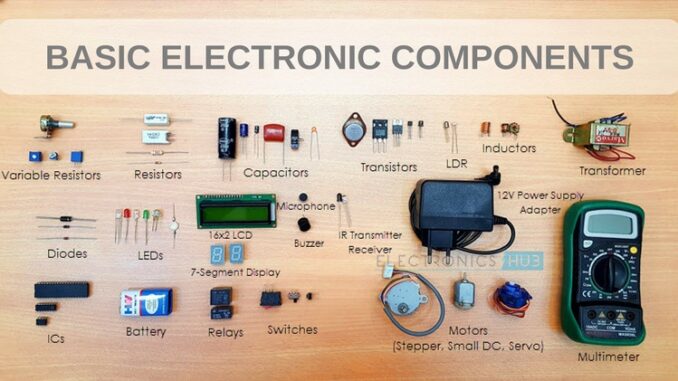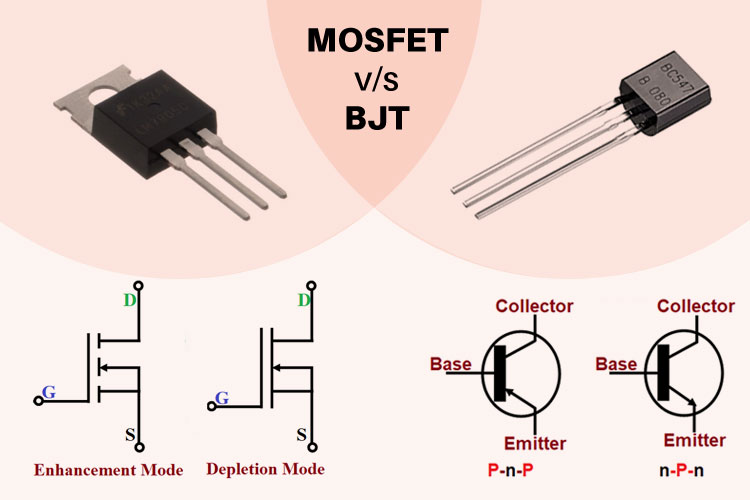
Table of Contents
ELECTRONIC COMPONENT TYPES
There are two kinds of these: passive and active components.
These components can be either through-hole or surface-mount.
Passive Elements
These are the components that do not have gain or directionality. Electrical elements and electrical components are other names for them.
Examples include resistors, capacitors, diodes, and inductors.
Active Components
These are the components that have gain or directionality.
Transistors, Integrated Circuits (ICs), and Logic Gates are some examples.
BASIC ELECTRONIC COMPONENT FUNCTION
- Terminals and Connectors: Electrical connecting components.
- Resistors are components that resist current flow.
- Switches: Components that can be made to conduct (closed) or not conduct (open) (open).
- Components that store electrical charge in an electrical field are known as capacitors.
- Electrical components that utilize magnetism are known as magnetic or inductive components.
- Components in a network that uses more than one sort of passive component.
- Piezoelectric devices, crystals, and resonators are examples of passive components that make advantage of the piezoelectric effect.
- Semiconductors are electronic control components that have no moving parts.
Diodes are basic electronic devices that exclusively carry electricity in one direction. A diode is an electrical component with two terminals. It is capable of controlling the flow of electricity. A diode can be compared to a switch.
Basic circuit functions include:
- Allow current to flow in only one direction.
- It is used for half-wave rectification.
- Rectification of the entire waveform (for designing a power supply)
- It serves as a signal clipper and clamper for us.
- A transistor is a semiconductor basic electronic device that can amplify signals.
- Integrated Circuits (ICs): A microelectronic computer circuit embedded on a chip or semiconductor; a whole system as opposed to a single basic electronic component.
LED is an abbreviation for light-emitting diodes. These are the basic electronic diodes that glow and emit light when a voltage is applied to them.
The majority of LEDs have two terminals and come in a variety of forms and colors.
LED circuit functionalities
An LED’s primary use is to provide illumination for troubleshooting and decoration purposes.
The Zener Diode
A Zener diode is another form of diode. It is useful when we need to filter out specific voltage levels or when we need steady voltage levels all of the time.
The Schottky diode
When it comes to quick switching, the standard diode falls short. As a result, the Schottky diode was designed to fill a requirement for a fast-switching diode. A Schottky diode, such as the one shown above, is a two-terminal electrical component.
Basic circuit functions include:
The primary purpose of this diode is its quick recovery time.
Quicker switching
Forward voltage drop is extremely minimal. SCR is an abbreviation for the silicon-controlled rectifier. These are the four-layer diodes that are used in practically all high-power devices.
Transistors (BJTs) (BJTs)
You know, I feel there would be no such technological growth in the world if the transistor had not been invented.
It is a basic electronic crucial component among all the others. A transistor is a three-terminal component that can control current, amplify a weak signal, and alter the load or state of the circuit automatically.
The following are the primary roles of a transistor in a circuit:
- Amplification
- Switching
- Control Safety
There are different types of transistors. The following are the most commonly used:
Bipolar junction transistors (BJT) MOSFETs IGBTs JFETs
Let’s look at these types in more detail in the parts that follow.
Because we are interested in electronic components, symbols and functions are of particular importance to us.
PNP and NPN
BJTs are classified into two types: NPN and PNP.
P-type material is sandwiched between N-type materials in NPN. PNP, on the other hand, has P-type material in the center.
Both of these classes perform the following tasks:
- They can be used as a switch.
- It can be used to boost weak signals.
- It can be employed in the circuit as a gain supplier.

MOSFETS is an abbreviation for metal oxide silicon field-effect transistors. And its fundamental purpose, or difference, is that it has extremely fast switching capability.
It contains three terminals that are labeled drain, source, and gate.
Integrated Circuits (ICs)
Integrated circuits are basic electronic critical components of modern technology. Tiny blocks of circuits are placed together in a small box to fulfill a specific duty in integrated circuits.
Most integrated circuits are made up entirely of millions of transistors.
Tens of millions of transistors collaborate in the signal IC chip of a mobile CPU. This figure is rising due to the increased demand for faster speeds.
Regulators
We don’t like shifting voltage levels in electronics. They are considered unstable and can occasionally produce erroneous outputs.
We employ regulator ICs on the output side of a power supply or in any other instance to obtain the contact voltage level.

Symbols for electrical components
So far, we’ve been discussing basic electronic component symbols and functions. Let us now turn our attention to electrical components.
The resistor
A resistor is the first item on the list. I’m sure most of you have heard of him. It is extremely prevalent and is found in practically every electrical and electronic circuit.

Leave a Reply